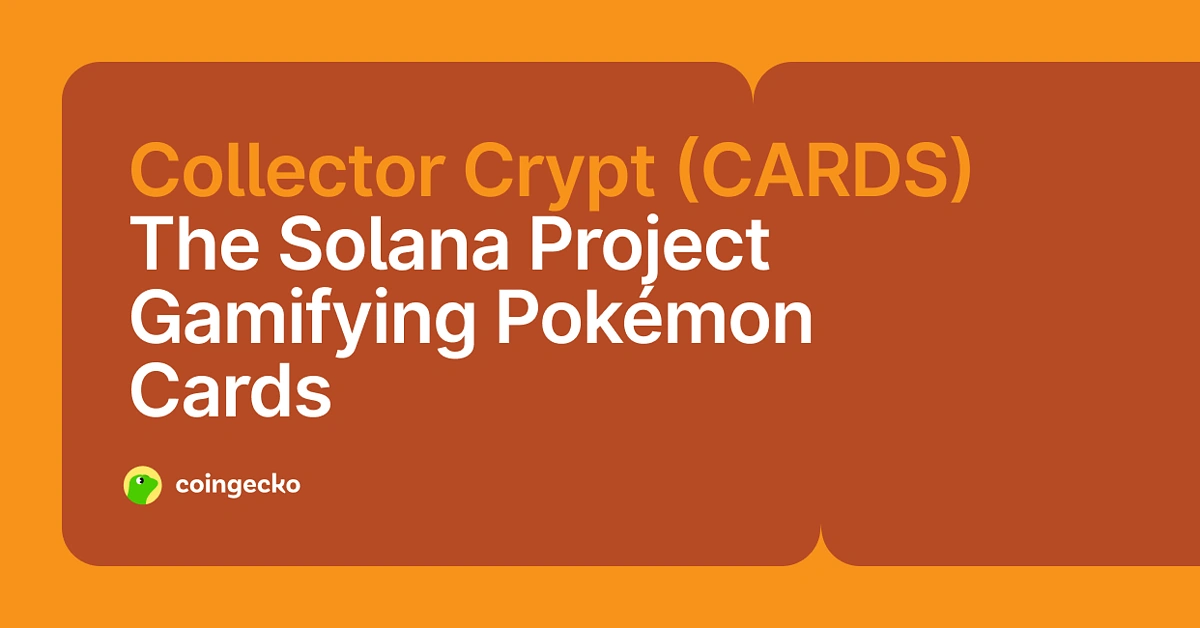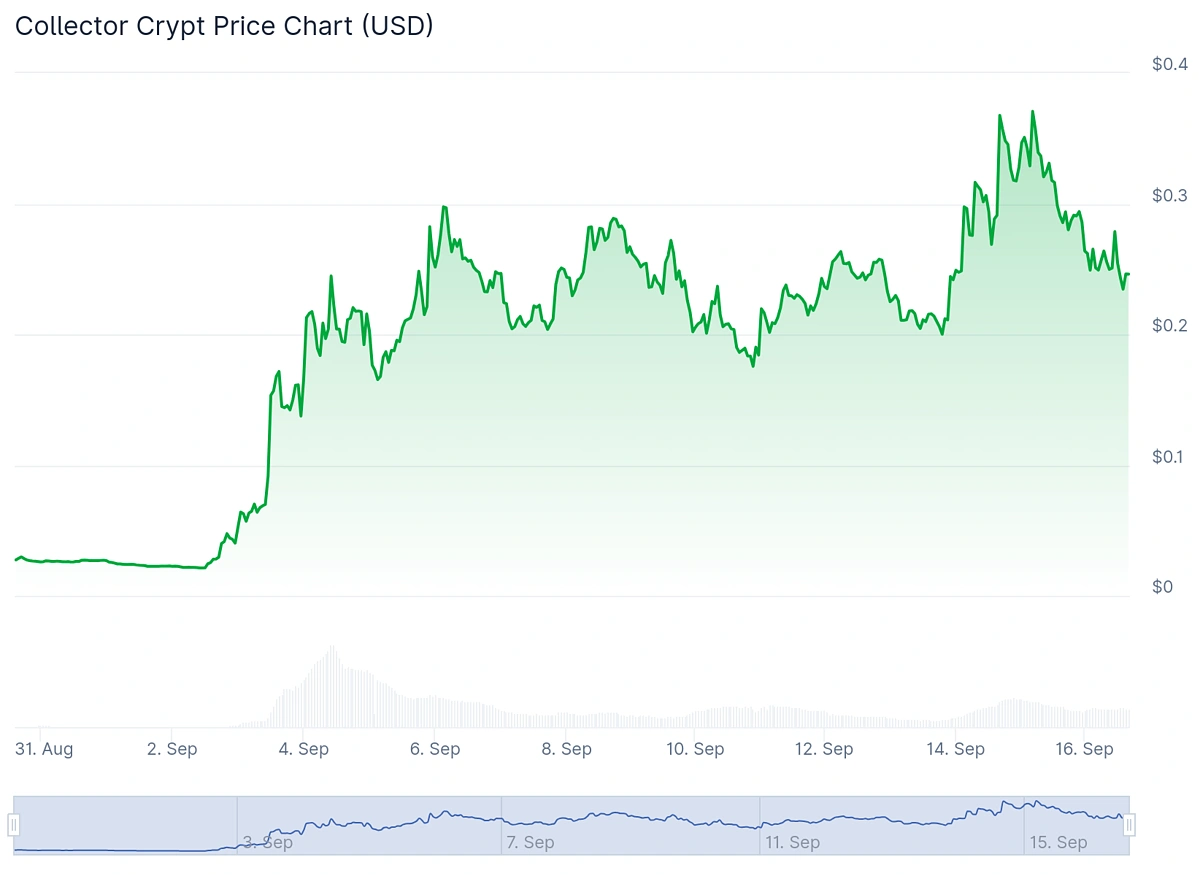What Is Collector Crypt (CARDS)?
Collector Crypt is a Solana platform that digitzes physical Pokémon cards into tradeable NFTs, with CARDS as its native token. Its most notable feature is its gamified “Gacha Machine”, where the project offers to buy back unwanted cards at 85% of expected value.
Key Takeaways
-
Collector Crypt is a Solana-based platform that tokenizes physical trading cards, such as Pokémon cards, turning them into redeemable Non-Fungible Tokens (NFTs) that can be traded on-chain.
-
The platform’s primary feature is the “Gacha Machine,” a gamified system where users buy randomized NFT packs with the option to sell unwanted cards back to Collector Crypt at 85% of expected value, which has driven the majority of its revenue and trading volume.
-
The CARDS token serves as Collector Crypt’s treasury-backed utility token, with 100% of net token sale proceeds funding a physical trading card treasury that powers the platform’s Gacha Machine, marketplace liquidity, and third-party partnerships.

Collector Crypt is a platform on the Solana blockchain that aims to modernize the trading card market by transforming physical collectibles into tokenized Real World Assets (RWAs). The project captured significant attention in late 2025 following the launch of its native token, CARDS, which experienced a price surge of over 600% within days of its debut. This rapid growth was fueled by a combination of a compelling real world asset (RWA) narrative, impressive on-chain metrics, and a unique, gamified approach to collectible trading—most notably through tokenized Pokémon cards.

This article provides a deep dive into the Collector Crypt ecosystem, its Gacha-centric business model, the tokenomics of the CARDS token, and the potential risks associated with the project.
How Collector Crypt Works: Physical-to-Digital Card Tokenization
Collector Crypt’s core function is to create a bridge between the physical and digital worlds of collecting. The process allows users to trade ownership of physical cards with the speed and efficiency of the blockchain, while the actual cards remain securely stored.
Collector Crypt Vaulting and Minting Process: Converting Physical Cards to NFTs
The journey begins when a collector sends their physical trading cards to one of the platform’s secure, third-party vaulting partners, such as PWCC. The platform primarily accepts cards that have already been professionally graded by reputable services like PSA (Professional Sports Authenticator), BGS (Beckett Grading Services), and CGC (Certified Guaranty Company), as this provides a trusted standard for authenticity and condition.
Once a card is received and verified at the vault, Collector Crypt mints a corresponding “pNFT” (physical Non-Fungible Token) on the Solana blockchain. This pNFT serves as a digital certificate of ownership—a “digital IOU”—that is cryptographically linked to the specific card held in storage. This model eliminates the need for physical shipping between traders, reducing costs, settlement times, and the risk of damage or loss in transit.
The On-Chain Marketplace
Once minted, the pNFT can be traded on Collector Crypt’s native marketplace or on other compatible Solana NFT marketplaces like Magic Eden. This interoperability expands the potential liquidity and audience for sellers.
The platform’s fee structure is a key part of its value proposition. For sellers, Collector Crypt charges a 2% fee, which is composed of a 1% platform transaction fee and a 1% royalty. This is substantially lower than the 13.25% in fees charged by eBay, the primary market for collectible cards, even if one takes into account the additional redemption fee, which is 2% of the card’s insured value.
Redeeming Your Cards
The link to the physical asset is maintained through a redemption process. An NFT holder can choose to “burn” their pNFT at any time via the Collector Crypt website. This action permanently removes the digital token from circulation and instructs the vaulting partner to ship the physical card to the owner. The redemption process requires the user to pay a 2% vault withdrawal fee, based on the card’s insured value, in addition to all shipping and handling costs.
Collector Crypt Gacha Machine: Gamified Pokémon Card Packs and the Platform’s Economic Engine
While Collector Crypt has a standard peer-to-peer marketplace, its most popular and economically significant feature is the “Gacha Machine”. The term “Gacha” is derived from Japanese toy vending machines and refers to a game mechanic where users receive a randomized virtual item.
How Collector Crypt’s Gacha System Works
Collector Crypt’s Gacha Machine is a digital vending machine where users can purchase randomized NFT packs using cryptocurrencies like Solana (SOL) or USDC. This experience is designed to replicate the thrill of opening physical booster packs, a core ritual in TCG (trading card game) culture. Unlike traditional pack-opening mechanics, Collector Crypt’s Gacha claims to offer positive expected value of +5 to +10%, making it a ‘gamified shopping experience’ rather than a gambling mechanism.
The Gacha has proven to be the primary driver of platform activity, generating over $89 million in total sales at time of writing.
The Instant Buyback Feature
A key innovation within the Gacha system is the integrated instant buyback feature. After a user opens a pack, the platform presents an immediate offer to repurchase the revealed NFT, typically for 85% of its expected value.
This mechanic creates a soft price floor for assets, provides instant liquidity, and encourages a feedback loop where users often reinvest their proceeds into buying more packs.
Collector Crypt’s Gacha Revenue Performance
On-chain data from Dune Analytics reveals Collector Crypt’s Gacha-driven business model has generated $89.5 million in total Gacha spending since inception. While this trails Courtyard’s market-leading $245.5 million, it substantially exceeds smaller competitors like Phygitals ($17.4 million) and Emporium ($663,360).
Recent performance demonstrates remarkable user demand intensity. In late August 2025, Collector Crypt sold approximately 14,000 $50 packs worth $700,000 in just one hour, translating to 233 packs per minute or 4 packs per second. The platform’s peak performance occurred on September 4, when it sold over $1.5 million worth of $250 legendary packs in under one hour.
There is strong pent up demand for @Collector_Crypt gacha machine. In the latest run, it sold ~14k $50 packs ($700k worth of spendings) in just 1 hour.
That translates to 233 packs per minute (4 packs/second).
In prior runs before downtime, approx 15-17k $50 packs were sold… pic.twitter.com/304fmgy9Gg
— zkayAPE 🎒(e/acc) (@zkayAPE) September 9, 2025
This data illustrates the stark dominance of Gacha mechanics over traditional peer-to-peer trading within the tokenized Pokémon card ecosystem, with the gamified pack-opening experience driving the vast majority of platform revenue and user engagement.Retry
CARDS Token: Collector Crypt’s Native Cryptocurrency
The CARDS token is the native utility token of the Collector Crypt ecosystem. It is designed to facilitate transactions and provide the liquidity that underpins the Gacha and buyback systems.
Supply and Distribution
CARDS has a fixed maximum supply of 2 billion tokens. The token allocation is distributed as follows :
-
Foundation: 36.76%
-
Community: 20%
-
Team: 19.5%
-
Pre-seed & Seed Investors: 11.87%
-
Advisors: 4.37%
-
Genesis Launch Pool (Public Sale): 5%
-
On-chain Liquidity: 2.5%
A notable aspect of this distribution is that approximately 75% of the total supply is allocated to the team, foundation, and early backers, which could present a long-term risk of token dilution.
CARDS Treasury Model: How Token Sales Fund Card Inventory
Collector Crypt has marketed CARDS as a “treasury-backed” token, stating that 100% of the net proceeds from its public sale are used to purchase physical trading cards for the platform’s treasury.
It is crucial to understand that this does not mean the token’s value is directly collateralized by these cards. Instead, the treasury serves as a liquidity engine that powers multiple platform functions: fueling Gacha machines, providing marketplace liquidity, and enabling partnerships with third parties who want to access trading card liquidity on or off-chain.
Importantly, none of the launch pool proceeds fund development, team payments, or marketing costs. The platform’s revenue model is designed around buybacks and platform fees, while token sale proceeds are exclusively allocated to card acquisitions.
Following the TGE, the platform plans to roll out additional features and integrations around the CARDS token.
Risks and Challenges Around Collector Crypt
Despite its initial success, Collector Crypt presents several significant risks that warrant careful consideration.
-
Token Dilution: With approximately 75% of the token supply held by the team and investors, there is a substantial risk of future selling pressure as these tokens unlock over time.
-
Centralized Custody Risk: The entire value of the platform’s NFTs depends on the security and integrity of its third-party vaulting partners. This centralization creates a single point of failure; any operational issue or breach at the vault could render the NFTs worthless.
-
Sustainability of the Gacha Model: The platform’s business model is overwhelmingly reliant on its Gacha feature, which thrives on market hype and a continuous inflow of new capital. This model may prove difficult to sustain outside of a bull market or if user excitement wanes.
Conclusion
Collector Crypt has successfully leveraged the RWA narrative, gamification, and a crypto-native token strategy to create a high-growth ecosystem on Solana. Its model offers a compelling solution to the friction points of the traditional collectibles market, such as high fees and slow settlement times.
However, the project’s long-term viability will depend on its ability to address significant challenges, such as managing the risks of its Gacha-centric model. While its innovative approach has captured the market’s attention, the associated risks make it a high-risk, high-reward proposition in the emerging field of collectible capital markets.
